How Instagram opened a new world for Welsh quilting
 Amgueddfa Cymru - National Museum Wales
Amgueddfa Cymru - National Museum WalesThey were once unloved and discarded as worthless old blankets.
But after a boom in younger people taking up quilting during the pandemic and posting pictures of intricate throws on social media, Welsh quilts are in vogue.
Displayed in art galleries and museums, some of the throws are selling for thousands.
One woman who spent years trying to save quilts from landfill says she felt a "bit like a crusader".
When Jen Jones, from Stockbridge, Massachusetts, arrived in the UK in 1970, she found people were throwing quilts away.
"Huge numbers were lost because people tossed them out in the 60s and 70s as heavy old bedding," said Ms Jones, who runs the Welsh Quilt Centre in Lampeter, Ceredigion, and now has over 400 in her private collection.
"I found them on hot water tanks and over tractors," she said, adding she bought some for £1 from "under tables". "It really upset me," she added.
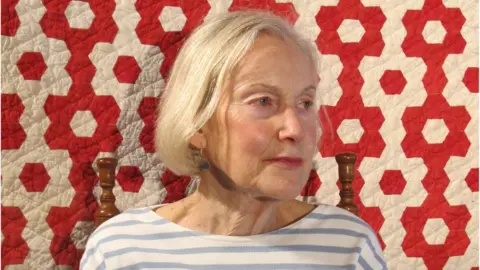 Welsh Quilt Centre
Welsh Quilt CentreBut interest in Welsh quilts has grown over the past decade, and boosted further in recent years.
Quilting became a hobby as a way to pass time during lockdowns, with people sharing their creations on social media. An increased focus on sustainability has also contributed to the popularity of the craft.
Many now share Ms Jones' passion for the throws, with some antique quilts made by highly skilled women now being sold for thousands to collectors around the world.
"When I first started there were hundreds of them going spare and not being looked after. That isn't the case now," Ms Jones said.
Instagram is awash with images of beautiful quilts, made of pieces of material cut into shapes to form patterns, and quilt-inspired looks have become a fashion trend.
"Instagram has opened up a whole new quilting world," says Elen Phillips, curator at St Fagans National Museum of History, in Cardiff.
"I think social media has played an important part in that resurgence, especially among young people."
 Welsh Quilt Centre
Welsh Quilt CentreMs Phillips, Principal Curator of Contemporary and Community History at the museum, said the climate crisis had added to the demand for handmade, quality goods.
"There's more of an awareness of things like our carbon footprint, consumerism of fabric and traceability of the things we wear and have in our home," she says.
In addition, there is an appreciation for making things by hand, and for knowledge that has been handed down.
For Bridget Taylor, 46, from Cardiff, quilting is all about keeping a family tradition alive.
'I'm finishing my mum's quilts'
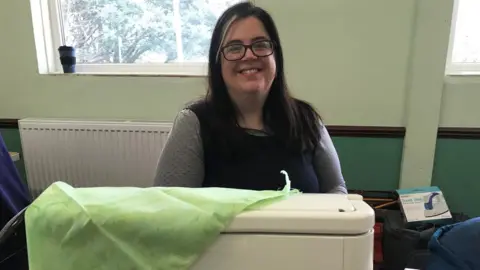
"My grandmothers, my great aunts, my great grandmas, they all quilted," she said.
Her mother died last summer and she is finishing some of her quilts. "I have eight kids. So (I am) making sure each of them has an heirloom quilt to themselves," she said.
Originally from northern West Virginia in the United States, Ms Taylor said a lot of the Welsh patterns are very similar to those used back in America, and many told a story.
She is attending a Saturday morning workshop hosted by Cardiff Quilters. The all-female group meets twice a month and has 45 members.
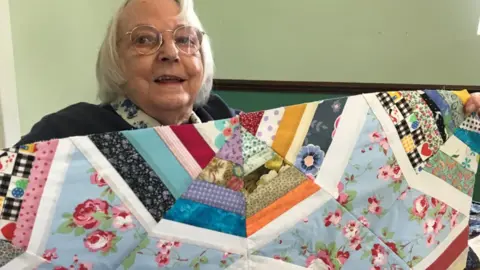
Barbara Turton, 76, a former chairwoman of the group from Caerphilly, has witnessed the growing interest in quilting in Wales.
"In the early 90s, there were probably two groups," she says, adding that now the Quilter's Guild lists 12 groups in South and mid Wales.
She said the quilts were now "becoming appreciated", with some selling for a lot of money.
"By the time I realised what was around, I couldn't afford it," she laughs.
From about 1850, up until the outbreak of the Second World War, quilting was a skilled occupation for women seeking to supplement their families' income.
Quilting classes, taught by the most established quilters in the area, were established in the depressed industrial valleys of south Wales in the 20s and 30s to produce very high-end quilts.
They were sold to upmarket department stores in Cardiff and London, or made for big hotels such as Claridges.
"It was an extraordinary time and the quilts had to be of the highest quality," Ms Jones said. "For a lot of women who went into it, it was a salvation really, it was not a hobby."
Highly prized
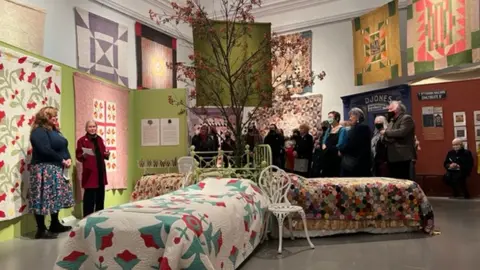 Welsh Quilt Centre
Welsh Quilt CentreHistorians also believe the Welsh flannel geometric quilts influenced Amish quilts, many of which are now highly prized.
It is these Welsh flannel quilts, mainly from 1850 onwards, collector Ms Jones believes, that will become really iconic.
"I've heard more than one person call several of our quilts 'Rothkos'," she said, "It is something that strikes people, that they are works of art."
"The really good ones were done by professionals, and so the work is exquisite... if you have one, keep it as it will go up in value."
The most prized Welsh quilts are primarily known for their beautiful stitching patterns, the technique and the design. They were very densely quilted, with almost every inch of surface stitched.
Inspiration was often derived from nature and the designs frequently featured a central circle and recurring themes like veined leaves or hearts.
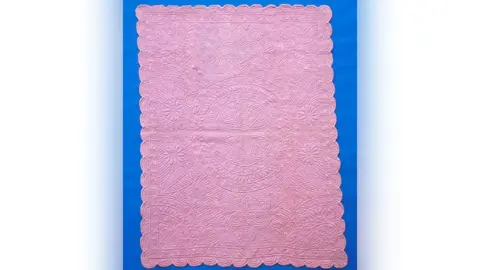 Welsh Quilt Centre
Welsh Quilt CentreMs Jones said there was now "huge interest" in quilts, not just from collectors in America, Japan and Australia, where quilting is big business, but increasingly also in the United Kingdom.
An antique Amish quilt in America can go for $90,000, she says; the equivalent here would now go for £5,000, she says, after being considered worthless for decades.
Few of the older quilts are dated or signed.
"They're made quite unselfconsciously," says Ms Phillips. But there are ways of suggesting a quilt comes from a particular area. "The trained eye can say it is indicative of a certain person's work, or trained by someone in particular."
 Amgueddfa Cymru - National Museum Wales
Amgueddfa Cymru - National Museum WalesMore often than not, quilts come to the museum through family members who will have associated stories with the quilt.
"It's very often through those family stories that we establish provenance," Ms Phillips says. "They are literally multi-layered in the stories and narratives that they hold. That's why they are so fascinating."
Some quilts in Ms Jones' collection, as well as a number of quilts from National Museum Wales have been on loan to Tate Britain in London.
"They're being appreciated by a new audience now and are being considered in a different light," Ms Phillips says.
"They really do warrant their place in art galleries because they are stunningly beautiful. The skill level is tremendous... they were made for a bed but wow, do they look amazing on a stark gallery wall."
